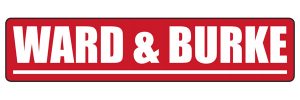Niagara Weir Stabilisation & Fish Pass (2023)
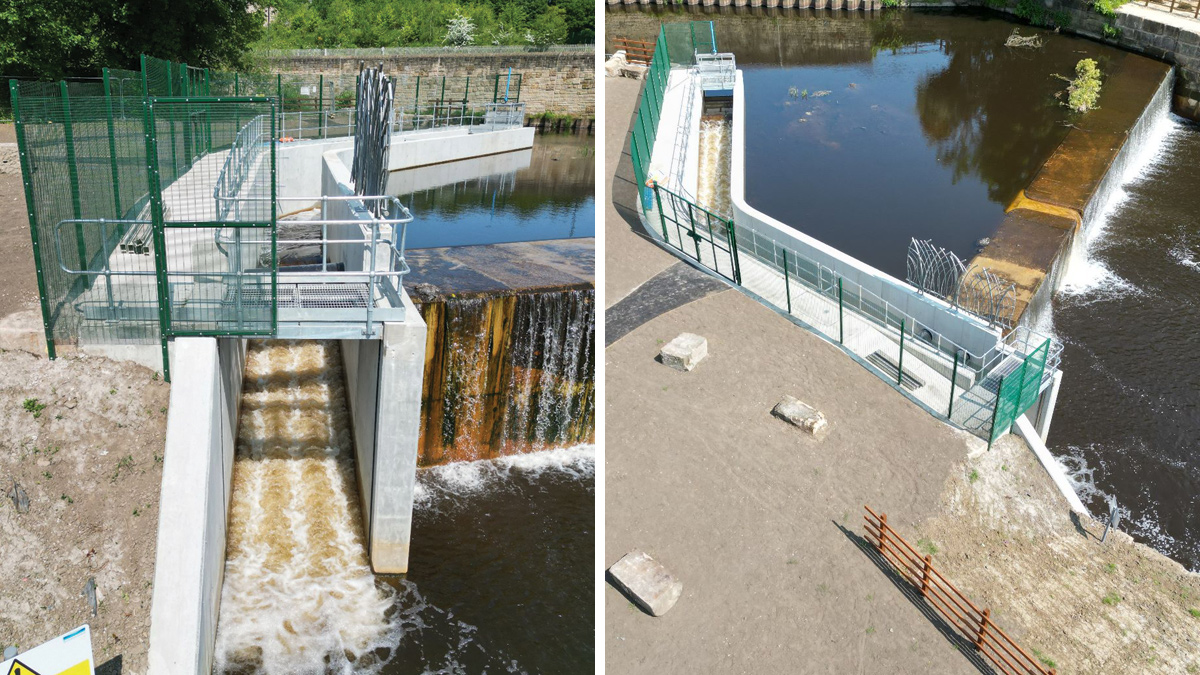
Fish pass in operation - Courtesy of Ward & Burke
During the industrial revolution, pollution and weir constructions in Yorkshire resulted in the rapid decline of river standards and loss of once abundant species such as salmon, trout, and grayling. The rivers were wiped of ecological habitats and the number of species found in the river declined by 83%. In 1999 Yorkshire Water installed the Niagara Weir to bridge two gravity fed sewer pipes across the river Don in Sheffield. Recently, juvenile salmon have been found in Sheffield, for the first time in over 150 years. Niagara Weir is one of the final barriers for migrating fish such as salmon and trout. This fish pass is the gateway to greater spawning habitats upstream that will boost their population to a sustainable size.
Project driver & scope of work
In 2016 the left bank’s masonry retaining wall downstream of the weir collapsed. A downstream masonry weir also collapsed, altering the river levels and rendering the existing fish pass unsuitable. Niagara Weir became undermined, compromising the two sewer pipes and threatening a pollution incident in the river. The work undertaken in this project included stabilising the weir to eliminate the pollution risk, rebuilding the collapsed left bank, and upgrading the fish pass to aid the migration of over half a dozen fish species of conservational importance.
Temporary works
During the design and construction phase, the two sewer pipes running through the weir were diverted into a temporary pumping station and pumped through pipework over the river. The temporary pipework was supported by a steel bridge, installed using a 220 ton crane. The original sewer pipes were isolated, eliminating the pollution risk.
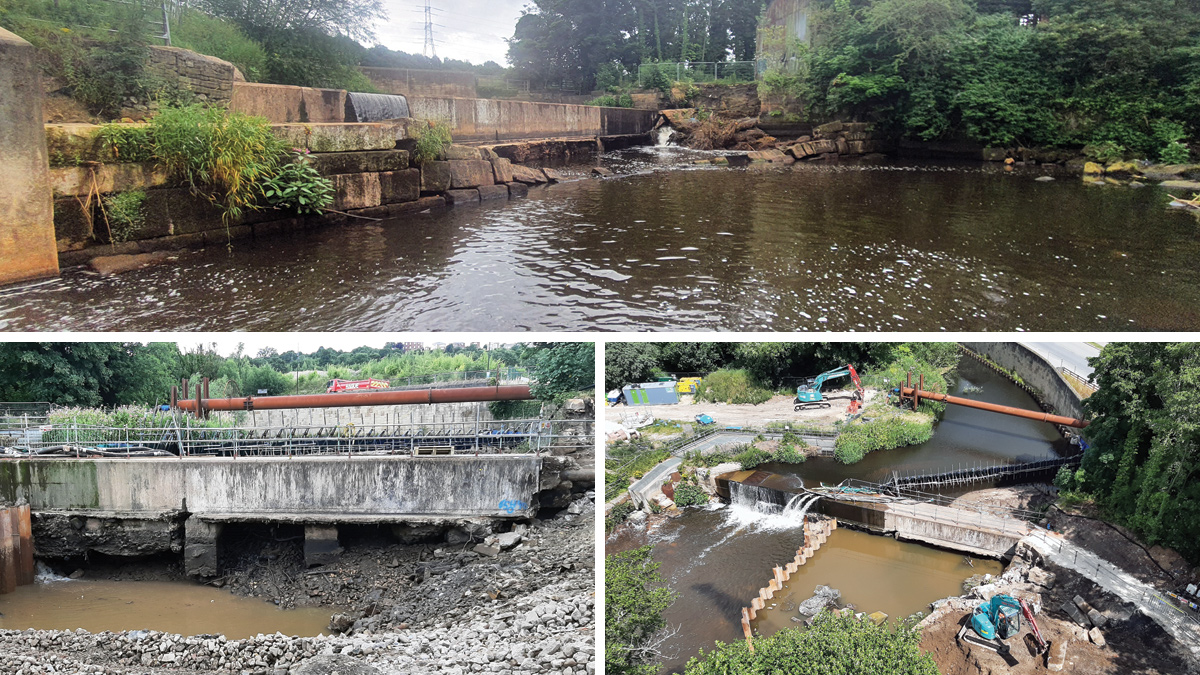
(top) Collapsed left bank and masonry weir, (left) left hand cofferdam dewatered, exposing the extent of the undermining to the weir foundations, and (right) sewer pipes diverted through a temporary bridge (PortaDam and cofferdam installed on the left hand side of the river) – Courtesy of Ward & Burke
Cofferdams
To stabilise the weir, cofferdams were constructed upstream and downstream of the weir. The weir was monitored daily and was only allowed to move 5mm before posing a risk of damaging the sewer pipes encased inside. A flood risk assessment determined the cofferdam could span half the width of the river and must be flooded when local river levels reached Q10+500mm.
Construction began on the left bank, rebuilding the bank and stabilising the left half of the weir. A PortaDam was installed upstream of the river by OnSite Central Ltd. A cofferdam was installed downstream of the river by Ward & Burke. The cofferdam was made of PU18 sheet piles 6m long. An extra row of sheet piles were driven at each end of the cofferdam to form ‘wedges’ that were filled with puddle clay to seal the cofferdam to the bank and weir face. The top pile level was set so that the cofferdam would flood automatically when river levels reached Q10+500mm.
Flood prevention
Flooding was a major risk during construction. The risk was managed by continuous monitoring of upstream and downstream river gauges, weather predictions and surveys on site. The construction began June 2022 and completed April 2023. During this time to cofferdam flooded three times. Six temporary pumps were installed to dewater the cofferdam. The pumps discharged into settlement tanks. The settlement tanks discharged through silt socks and the effluent filtered through the grassy bank before returning to the river.
Weir stabilisation works
Once the left bank cofferdam was dewatered, the full extent of the undermining was assessed. Shotcrete was used to stabilise the fill material underneath the concrete weir. Then a 4.5m wide slab and 1.45m tall toe were constructed at the base of the weir. A similar 2.5m wide slab and toe was constructed along the left bank.
The initial design involved a large mass concrete fill as the left bank retaining wall. Collaborative working during the design phase enabled Ward & Burke to query the function of this mass fill with the designers. An assessment was made and the design was altered, reducing the size of the excavation and replacing the mass fill with an RC wall. This reduced the embodied carbon by 40%. Furthermore, it improved the buildability, making the construction process safer.
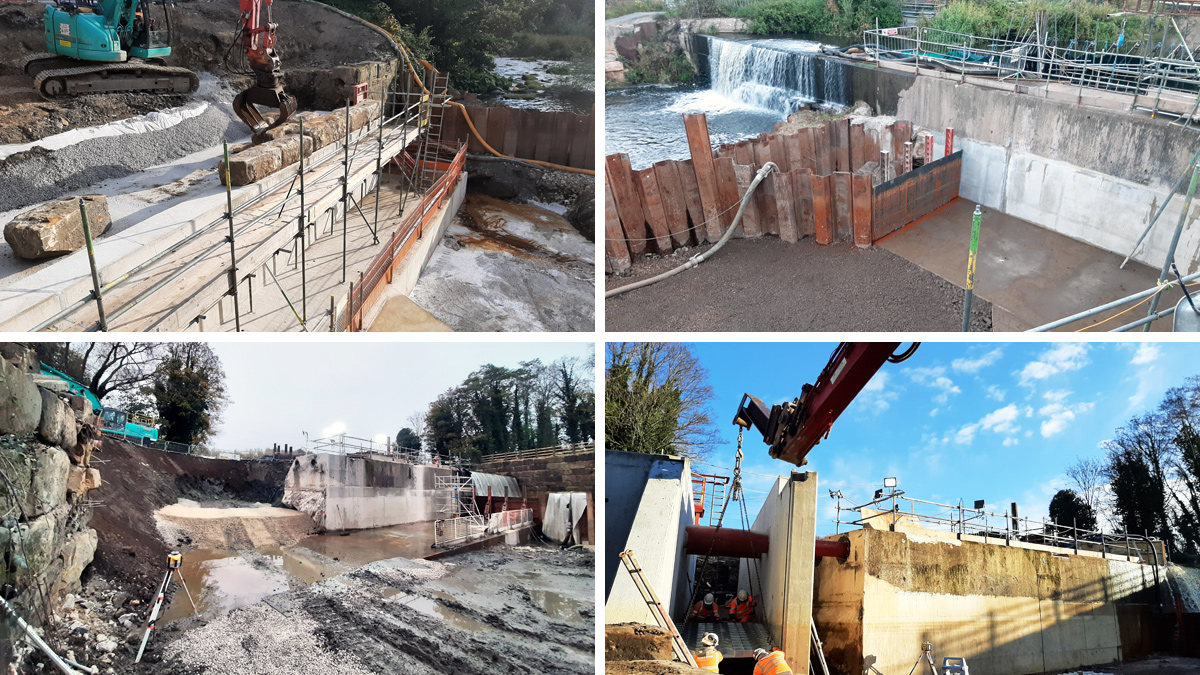
(top left) Left bank foundation RC slab and wall built, excavator grab positioning reclaimed stone wall, (top right) left half of weir stabilised, shutter for right hand cofferdam installed, river bed graded ready for flooding, (bottom left) with the weir stabilisation complete the existing fish pass and part of the weir are demolished to make room for the new fish pass, and (bottom right) sewer pipes reconnected through the fish pass walls – Courtesy of Ward & Burke
During construction, large stones from the collapsed downstream weir and left bank were recovered from the river. The design was altered to reuse these stones and incorporate them into the structure, avoiding embodied carbon associated with the original proposed concrete structures and imported aggregate. The stones were used to rebuild the left bank, installed as scour protection on the right bank, and used to landscape canoe landings. The stones helped the structure blend harmoniously with the surrounding environment.
Before flooding the left bank downstream cofferdam, a steel shutter was designed and installed on the new concrete slab to seal the proposed right bank cofferdam to the weir face. This enabled part of the right bank cofferdam to be constructed within the left bank cofferdam, ensuring a better seal and reducing risks associated with piling in the river.
Once the left bank was complete and the left half of the weir stable, the cofferdams were flooded and removed.
A similar process was followed on the right bank to stabilise the weir. Sheet pile cofferdams were installed upstream and downstream of the weir. Temporary pumps kept the cofferdams dewatered.
Niagara Weir Stabilisation: Supply chain – key participants
- Principal contractor: Ward & Burke
- Principle designer: JBA Consulting
- PortaDam: OnSite Central Ltd
- Cofferdam props: MGF Ltd
- Larinier baffle fabrication: C&D Engineering Services
- Handrail & access metalwork: Galliford Try Fabrications
- Penstock & stoplogs: Midland Valves
- Security fencing: Burn Fencing Ltd
- Concrete: Right Mix Concrete Ltd
- Concrete: Breedon Group
Fish pass
A new 1.8m wide 30m long Larinier fish pass was designed to replace the existing Alaskan A fish pass. The fish pass wall height varies from 4.1m to 1.28m, as the water level drops 2.9m over the weir.
The fish pass consists of two 10m long Larinier baffled flights with a resting pool in the middle. Galvanised steel baffles are installed on the 8.53° flights. The baffles were fabricated in six pieces by C&D Engineering Services. The material was laser cut to ensure a tolerance of 1mm. It was critical that the shape, location, and height of the baffles were accurate to achieve the most efficient hydraulic flow for the fish. These baffle sections were slung and lifted into position with an accuracy of +/- 1mm. When all the baffles were in position and fixed to the base, grout was poured underneath to ensure they were fully sealed.
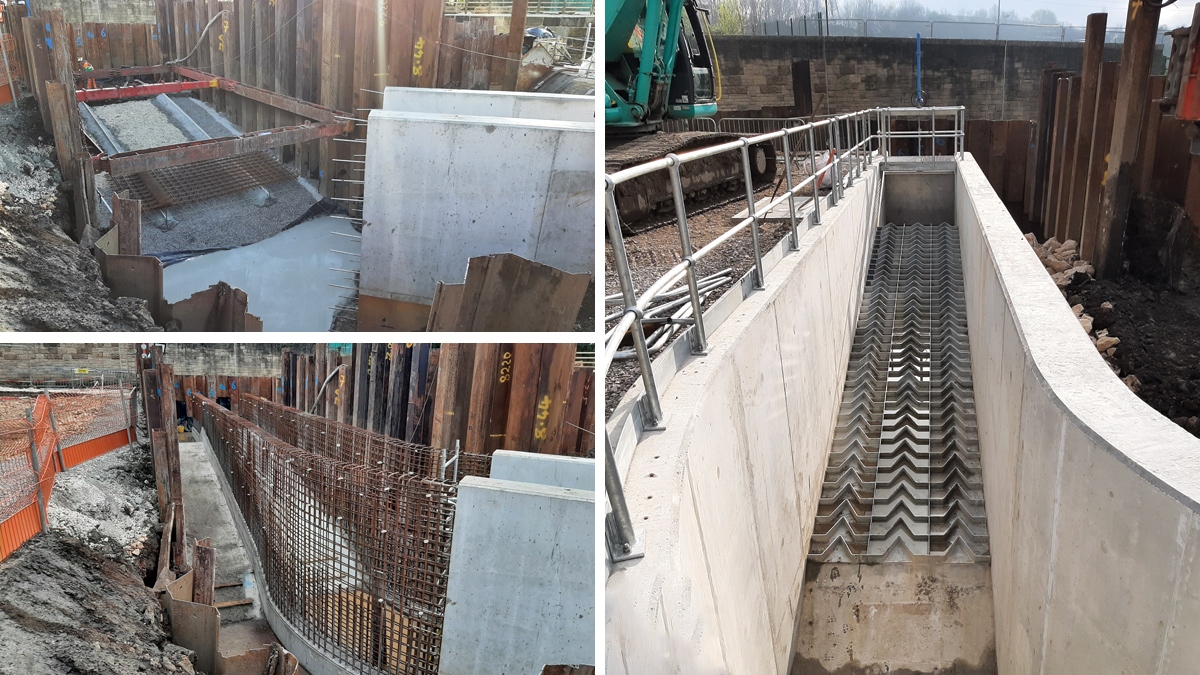
(top left) Propped cofferdam for upstream section of fish pass, preparing for blinding, (bottom left) fish pass wall rebar, upstream section, and (right) upstream baffles, penstock, and access metalwork installed in fish pass – Courtesy of Ward & Burke
Midland Valves supplied a penstock upstream and stop logs downstream to isolate the fish pass for maintenance. The penstock and stop log frames were cast into the fish pass walls, flush with the base of the fish pass. This avoids grit being caught in the frame, preventing a tight seal.
The fish pass was constructed in two halves; upstream and downstream of the weir. The two sewer pipes were cast into the walls of the downstream section. The downstream section was constructed first so that the sewer pipes could be re-energised and the temporary pumping station decommissioned before the end of the whole project.
To construct the downstream section of the fish pass, a section of the weir and sewer pipes were removed. Then the ground was formed and blinded with a 8.53° slope. The base steel was fixed and the base poured. Next the wall steel was tied, shutters erected and the walls poured. The walls were constructed with a tolerance of +-5mm to ensure the baffles could fit and there wasn’t excessive space for debris to get caught. For the construction of the walls, the formwork panels had to be stepped to tie in with the run of the slope. The on-site joiners made relevant angled shutter bases to integrate with the main wall shutters so each wall could be poured in one go.
To construct the upstream section of the fish pass, a new cofferdam was installed. The cofferdam was initially propped with MGF frames. The blinding was designed strong enough so that the MGF frames could be removed once it reached strength. It was important that the MGF props were removed because they would have clashed with the fish pass wall, and limited lifting operations in the cofferdam. The construction process was repeated and the fish pass base and walls were poured.
Surveys and inspections of the fish pass by Yorkshire Water and the Environment Agency confirmed that the overall design and construction of the structure was satisfactory and within the design specification. On confirmation of this, the dewatering pumps were decommissioned and the sheet piles removed from the river to allow flows through the new pass.
A 160t crane was employed to remove the sheet piles upstream of the weir. The excavator that had driven them in could not reach over the new fish pass.
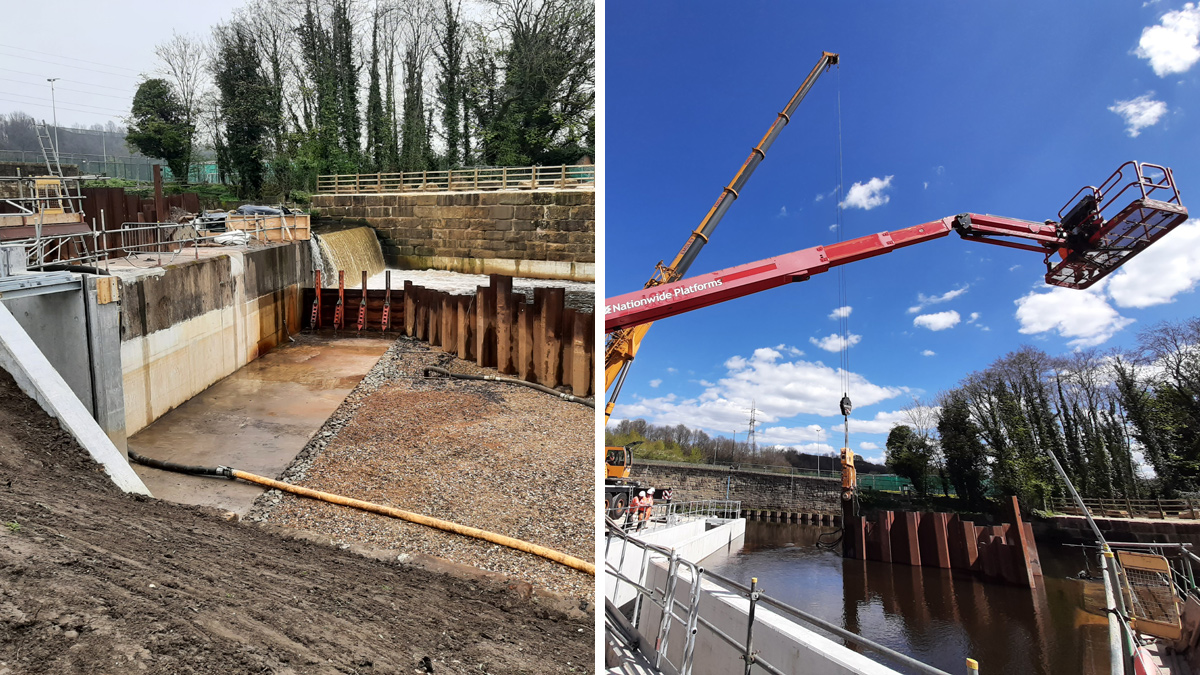
(left) right bank cofferdam, looking at the rebuilt left bank masonry wall (and right) 160 ton crane and vibro hammer removing the upstream cofferdam – Courtesy of Ward & Burke
Legacy
Niagara Weir Fish Pass is located on public land owned by Sheffield Council, situated next to football pitches behind a housing estate. After the project was complete, the area was landscaped and returned to public use. Canoe portages were constructed upstream and downstream of the weir, using the reclaimed Yorkshire stones from the river.
Conclusion
The River Don has long been blocked by barriers and now opening them up is creating a wealth of virgin habitat that could boost the fish populations massively. The main species the fish pass is aimed at (salmon, trout, grayling) are under threat due to climate change. Indeed salmon are considered so threatened now that they could disappear in the next 20 years without help. The River Don is vital in safeguarding these fish against climate change due to its location in England and size of the estuary into which it flows. Niagara Weir Fish Pass was completed and opened in May 2023.



